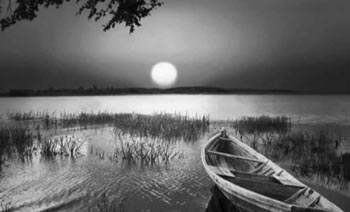
[Your computer might ask you to allow the music to play on this page]
The Water Is Wide |

How much emotion can you pack into a song? Well, I guess that depends on the song and the musician or singer. The Water Is Wide is one that begs for emotion although not everyone has played it that way.
To introduce it, here is a video by pianist and saxophonist Annette Kreutz and Carolin Hild:
The water is wide,
I can't cross over,
And neither have I wings to fly.
Build me a boat
That can carry two
And both shall row, my love and I.
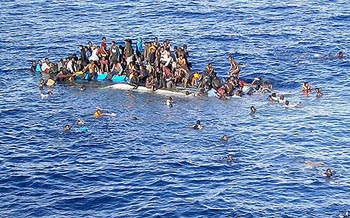
The Water Is Wide is a traditional Scottish song. The lyrics we know best have, over time, emerged from the original lyrics and we'll visit those later, but for now we'll stick with those that are most familiar.
Now, in 2016, it is difficult not to read these lyrics without thinking of the current 'migration crisis', people leaving their countries for various reasons, paying large sums of money for a place on a crowded boat that might or might not make it across the sea. The hundreds that drown at sea.
There is a ship
And she sails the sea.
She's loaded deep,
As deep can be.
But not so deep
As the love I'm in,
I know not how I sink or swim.
And then the last verse that reflects attitudes to migration, the sympathy for those in desperate need and seeking safety and then a changing attitude as numbers of migrants increase.
Oh love is handsome
And love is fine,
The sweetest flower
When first it's new.
But love grows old
And waxes cold
And fades away like Summer dew.
That is not, of course, the origin of the song which is also known as O Waly, Waly. The original lyrics go back to the 1600s. Cecil Sharp 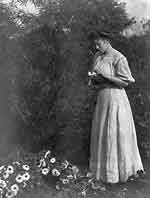 published the song in Folk Songs From Somerset (1906), and it is said that it is possibly based on the unhappy first marriage of James Douglas, 2nd Marquis of Douglas to Lady Barbara Erskine. It is that sadness in a relationship that 'grows cold' that forms the heart of the song and part of the emotion that goes with it, but it is also something in the composed music that wrings emotion out.
published the song in Folk Songs From Somerset (1906), and it is said that it is possibly based on the unhappy first marriage of James Douglas, 2nd Marquis of Douglas to Lady Barbara Erskine. It is that sadness in a relationship that 'grows cold' that forms the heart of the song and part of the emotion that goes with it, but it is also something in the composed music that wrings emotion out.
The story of James Douglas is told something like this: James, second marquis of Douglas, born in 1646, succeeded his grandfather, William Douglas, in 1660, and was a privy councillor to Kings Charles II and James VIII. James, a young man, after being engaged for marriage with the daughter of one Widow Jack, a taverner at Perth, was wedded at Aba House to Lady Barbara Erskine, daughter of the Earl of Mar.
In 1681, Lowrie of Blackwood, who is said to have been a rejected suitor of Lady Erskine, told James that there was a rumour going round that Barbara had been sleeping with another man. James promptly dropped her and the child she had born him. The sorrows of the Marchioness of Douglas were described in a popular ballad of the day. Her father took her home and she never remarried.
Here is a great jazz rendering of the tune by the Charles Lloyd Quartet:
The lyrics to the song have often been changed over the years. Wikipedia tells us: 'The modern lyric for The Water Is Wide was consolidated and named by Cecil Sharp in 1906 from multiple older sources in southern England, following English lyrics with very 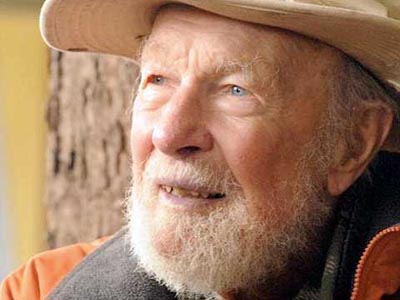 different stories and styles, but the same meter. Performers or publishers would insert, remove and adapt verses from one piece to another: floating verses are also characteristic of hymns and blues verses. Lyrics from different sources could be used with different melodies of the same metre. Consequently, each verse in the modern song may not have been originally composed in the context of its surrounding verses, nor be consistent in theme.'
different stories and styles, but the same meter. Performers or publishers would insert, remove and adapt verses from one piece to another: floating verses are also characteristic of hymns and blues verses. Lyrics from different sources could be used with different melodies of the same metre. Consequently, each verse in the modern song may not have been originally composed in the context of its surrounding verses, nor be consistent in theme.'
Pete Seeger
Pete Seeger popularised the modern version, but there are many old variants of the song. O Waly Waly (Wail, Wail) may sometimes be a particular lyric, sometimes a family tree of lyrics ... Benjamin Britten used the melody and verses of The Water is Wide for his arrangement - which does not have the O Waly, Waly verse, yet is titled Waly, Waly.
A different melody is used for the song When Cockleshells Turn Silver Bells, also subtitled Waly, Waly. A key ancestor is the lyric Waly, Waly, Gin Love Be Bonny from Ramsay's Tea Table Miscellany (1724). This is a jumble of verses from other lyrics including Arthur's Seat Shall Be My Bed (1701) and The Distressed Virgin (1633) ... The use of cockleshells and silver bells in Thomson's version (1725) pre-dates the earliest published Mary, Mary, Quite Contrary (1744), and may relate to torture ...'
Here is a short documentary with Pete Seeger about building a boat and which has footage of him singing The Water Is Wide. The documentary focuses on boats, in particular about building a replica of a sloop. Pete Seeger sings the song beautifully, but the background imagery of boats somehow detracts from the story behind the lyrics. (Pete Seeger's version is available on a double CD from Paul Adams's Fellside recordings (click here). Paul says: 'They come from two LPs issued by Doug Dobell - of Dobell's Record Shop - on his Folklore label which, like us, he ran alongside his Jazz label. Further, the tracks on the first of the double CDs were recorded by jazz musician and remastering engineer John RT Davies!').
'The Water is Wide also influenced lyrics for other folk and popular songs, such as the modern version of the Irish Carrickfergus (1960s) and the American Sweet Peggy Gordan (1880). The Irish song Carrickfergus, shares the lines but the sea is wide/I cannot swim over/And neither have I wings to fly. This song may be preceded by an Irish language song whose first line A Bhí Bean Uasal ("It was a noble woman") matches closely the opening line of one known variation of Lord Jamie Douglas: I was a lady of renown. However, the content of the English-language Carrickfergus includes material clearly from the Scottish/English songs not found in any known copy of A Bhí Bean Uasal, suggesting considerable interplay between all known traditions'. Although Carrickfergus also contains the lines I wish I had a handsome boatsman To ferry me over my love and I, it somehow lacks the emotion of The Water Is Wide (Carrickfergus is about someone missing their homeland).
A nice version of Carrickfergus by Loudon Wainwright III was used in the television series Boardwalk Empire. There are various versions of this on Youtube, I think this one has the better sound although unfortunately it cuts short at the end. It also shows a still from the film with the caption "They can drown for all I care, as long as they pay."
Which brings us to O Waly, Waly (Wail, Wail). The lyrics are much longer and sung specifically by a woman (The Water Is Wide could be by either gender). Wikipedia carries them (click here) and they scan to go with the tune we know. They also carry the emotion of a love betrayed and lost, even more than The Water Is Wide:
O waly, waly, but love be bonnie (beautiful),
A little time while it is new,
But when 'tis auld (old), it waxeth cauld (cold),
And fades away like the morning dew.
O wherefore should I busk my heid (adorn my head)?
Or wherefore should I kame (comb) my hair?
For my true love has me forsook,
And says he'll never love me mair (more).
....
O gentle death, when wilt thou come?
For of my life I am weary.
'Tis not the frost, that freezes fell,
Nor blawing snaws (snow) inclemency,
'Tis not sic cauld (such cold) that makes me cry,
But my love's heart grown cauld to me.
.....
Oh, oh! if my young babe were born,
And set upon the nurse's knee,
And I my sell were dead and gane,
For a maid again I'll never be.
So what is it about The Water Is Wide that carries the emotion? The lyrics are not long, within a short three verses the song captures the mood of hope turning to sadness and regret. Is it the lyrics that suggest the emotion or does the construction of the music also convey that same change in feeling?

In this version by Bänz Oester and The Rainmakers from 2012 the tune is taken much faster and the emotion in the song is only just held by the saxophone, but the fine interpretation is one of the few effective jazz improvisations of the song available on Youtube. I like this.
The 'The Water Is Wide' has been used more generally to describe difficult situations and the challenge or seeming hopelessness in 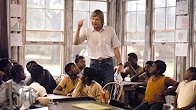 overcoming them. In 1972 Pat Conroy used The Water Is Wide for the title of his fascinating book based on his work as a teacher in South Carolina.
overcoming them. In 1972 Pat Conroy used The Water Is Wide for the title of his fascinating book based on his work as a teacher in South Carolina.
Daufuskie Island, which is called Yamacraw Island in the book is a poor island lacking bridges and having little infrastructure. The book 'describes Conroy's efforts to communicate with the islanders, who are nearly all directly descended from slaves and who have had little contact with the mainland or its people. He struggles to find ways to reach his students, ages 10 to 13, some of whom are illiterate or innumerate, and all of whom know little of the world beyond Yamacraw. Conroy (called "Conrack" by most of the students) does battle with the principal, Mrs. Brown, over his unconventional teaching methods and with the administrators of the school district, whom he accuses of ignoring the problems at the Yamacraw school.
The book was made into a film called 'Conrack' in 1974 starring a young Jon Voight. Here is an extract from the movie (which is available in full on Youtube).
So let's end by going back to the words and the tune with this version by Sheila Jordan and the E.S.P. Trio who take a slow approach to the song with some lyric changes but their interpretation has warmth ... and emotion?
The water is wide,
I can't cross over,
And neither have I wings to fly.
Build me a boat
That can carry two
And both shall row, my love and I.
© Sandy Brown Jazz